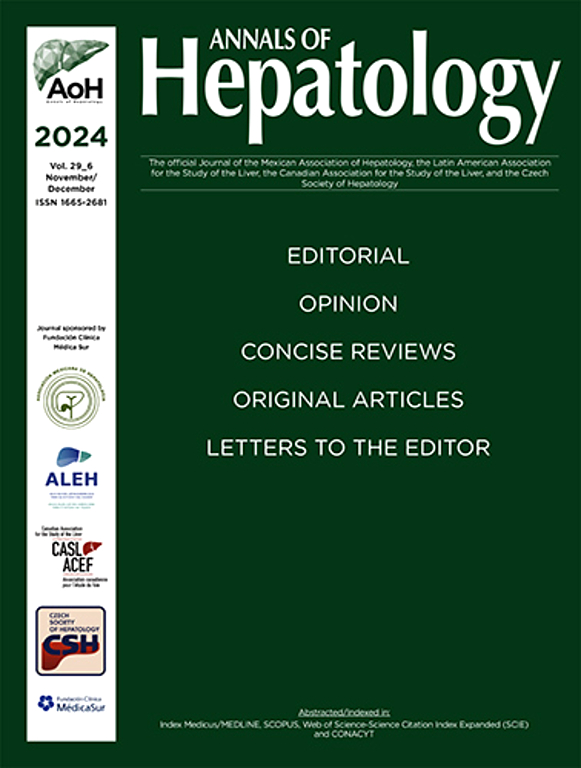使用直接作用抗病毒药物治疗的墨西哥人群中丙型肝炎病毒(HCV)感染引起的肝纤维化及其相关因素的回归初步研究。
IF 3.7
3区 医学
Q2 GASTROENTEROLOGY & HEPATOLOGY
引用次数: 0
摘要
在AAD患者获得持续的病毒应答后,纤维化的消退并不总是实现的。已经进行了研究,以确定可能涉及的因素,如年龄、体重指数、糖尿病、血脂异常和脂肪变性等。目的:确定与墨西哥华雷斯医院AAD患者肝纤维化消退相关的因素。材料和患者:2019年1月至2024年3月,对诊断为丙型肝炎病毒感染的患者进行了回顾性、观察性、横断面研究。考虑以下纳入标准:18岁及以上患者,接受sofosbuvir/velpatasvir 400mg/100mg治疗12周或glecaprevir/pibrentasvir 100mg/40mg治疗8周,治疗前FIB-4评分和APRI评分确定有明显纤维化(>F2)。排除标准:18岁以下、合并HBV感染和/或治疗不完全的患者。患者分为4组:第1组:无肝硬化且无相关合并症患者,第2组:无肝硬化但有相关合并症患者,第3组:肝硬化且无相关合并症患者,第4组:有肝硬化及相关合并症患者。各组治疗开始和治疗后分别测定FIB-4评分和APRI评分,评价组间纤维化消退的差异。结果共纳入51例患者,其中:第1组5例。在该组中,40%的患者在治疗后APRI期和FIB-4期均有所下降。组2:11例患者,45% APRI和FIB-4评分下降一期。第三组19例,治疗后APRI和FIB-4评分均无下降。第4组:16例患者,只有18.74%的患者在治疗后APRI和FIB-4期均有所下降,该组25%的患者仅在APRI期有所下降。结论在本初步研究中,大部分合并或不合并肝硬化及其他相关合并症(糖尿病、高血压、血脂异常和/或肝脂肪变性)的患者在治疗后APRI和FIB-4期均未下降。因此,应进行方差分析,以确定哪些因素影响纤维化回归,并应扩大样本量以获得显著结果。本文章由计算机程序翻译,如有差异,请以英文原文为准。
Regression of hepatic fibrosis due to hepatitis C virus (HCV) infection and its associated factors in Mexican population treated with direct-acting antiviral agents. A preliminary study.
Introduction and Objectives
After achieving a sustained viral response with AAD, regression of fibrosis is not always achieved. Studies have been conducted to determine factors that may be involved such as age, BMI, diabetes, dyslipidemia, and steatosis, among others. OBJECTIVE: To determine the factors associated with regression of hepatic fibrosis in patients treated with AAD at the Juarez Hospital in Mexico.
Materials and Patients
A retrospective, observational, cross-sectional study was conducted from January 2019 to March 2024 on patients diagnosed with hepatitis C virus infection. The following inclusion criteria were considered: Patients aged 18 or more who underwent treatment with sofosbuvir/velpatasvir 400mg/100mg for 12 weeks or glecaprevir/pibrentasvir 100mg/40mg for 8 weeks and had significant fibrosis (>F2) determined by FIB-4 score and APRI score before the treatment. Exclusion criteria: patients under 18 years of age, co-infection with HBV, and/or incomplete treatment. Patients were divided into 4 groups: GROUP 1: patients without hepatic cirrhosis and without associated comorbidities, GROUP 2: patients without hepatic cirrhosis but with associated comorbidities, GROUP 3: patients with hepatic cirrhosis without associated comorbidities, and GROUP 4: patients with hepatic cirrhosis and associated comorbidities. For each group, FIB-4 score and APRI score were measured at the beginning and after treatment to evaluate differences in fibrosis regression between groups.
Results
51 patients were recruited, of whom: 5 patients were part of Group 1. From this group, 40% achieved a decrease in stage APRI and FIB-4 stage after treatment. Group 2: 11 patients, 45% decreased one stage of APRI and FIB-4 score. Group 3: 19 patients, no patient achieved a decrease in APRI and FIB-4 score after treatment. Group 4: 16 patients, only 18.74% achieved a decrease in both APRI and FIB-4 stages after treatment, and the 25% of this group achieved a decrease just in APRI stage..
Conclusions
In this preliminary study, a major percentage of patients with and without hepatic cirrhosis plus another associated comorbidity (diabetes, hypertension, dyslipidemia, and/or hepatic steatosis) did not achieve a decrease in APRI and FIB-4 stages after treatment. Therefore, an analysis of variances should be performed to determine which of these factors impact fibrosis regression, and the sample size should be expanded to achieve significant results.
求助全文
通过发布文献求助,成功后即可免费获取论文全文。
去求助
来源期刊

Annals of hepatology
医学-胃肠肝病学
CiteScore
7.90
自引率
2.60%
发文量
183
审稿时长
4-8 weeks
期刊介绍:
Annals of Hepatology publishes original research on the biology and diseases of the liver in both humans and experimental models. Contributions may be submitted as regular articles. The journal also publishes concise reviews of both basic and clinical topics.
 求助内容:
求助内容: 应助结果提醒方式:
应助结果提醒方式:


